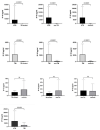IP-10 for the Diagnosis and Treatment Monitoring of Tuberculosis in Children
- PMID: 38248054
- PMCID: PMC10814829
- DOI: 10.3390/diagnostics14020177
IP-10 for the Diagnosis and Treatment Monitoring of Tuberculosis in Children
Abstract
Purpose: To determine the utility of interferon-gamma-inducible protein 10 (IP-10) for identifying active tuberculosis (TB) and TB infection (TBI) in children in BCG-vaccinated populations, establish its diagnostic performance characteristics, and evaluate changes in IP-10 level during anti-TB chemotherapy.
Methods: Concentrations of IP-10 and IFN-γ were measured in QuantiFERON-TB Gold (QFT) supernatants in children with suspected TB or due to recent TB contact. A total of 225 children were investigated: 33 with active TB, 48 with TBI, 83 TB contacts, 20 with suspected TB but other final diagnoses, and 41 controls. In 60 children, cytokine responses were evaluated at a follow-up visit after 2 months of anti-TB treatment.
Results: IP-10 expression was significantly higher in infected children (active TB and TBI cases) than in uninfected individuals. IP-10 proved effective in identifying TB infection at its optimal cut-off (>1084.5 pg/mL) but was incapable of differentiating between children with active TB and TBI. Combining IP-10 and IFN-γ increased the QFT sensitivity. IP-10 but not IFN-γ decreased significantly during anti-TB treatment in children with active TB (p = 0.003).
Conclusion: IP-10 identifies TB infection and declines during anti-TB chemotherapy in children. Incorporating IP-10 into new immunodiagnostic assays could improve TB diagnosis and allow for treatment monitoring.
Keywords: LTBI; Mycobacterium tuberculosis; TB contact; chemokine CXCL10; tuberculosis.
Conflict of interest statement
The authors declare no conflicts of interest.
Figures



References
-
- World Health Organization . Global Tuberculosis Report 2023. World Health Organization; Geneva, Switzerland: 2023.
-
- Farhat M., Greenaway C., Pai M., Menzies D. False-positive tuberculin skin tests: What is the absolute effect of BCG and non-tuberculous mycobacteria? Int. J. Tuberc. Lung Dis. 2006;10:1192–1204. - PubMed
LinkOut - more resources
Full Text Sources

